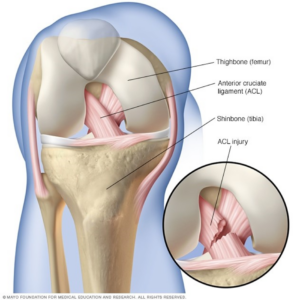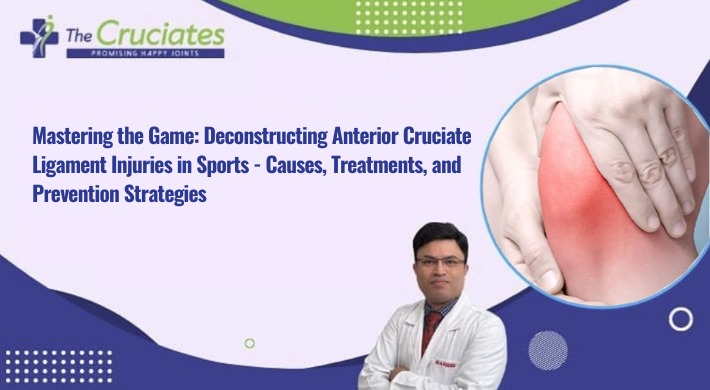In the high-stakes world of sports, athletes often push their bodies to the limit in pursuit of victory. However, this pursuit comes with its fair share of risks, one of which is the dreaded Anterior Cruciate Ligament (ACL) injury. ACL injuries have the potential to derail careers and significantly impact an athlete’s quality of life. In this blog, we will delve into the causes, treatment options, and prevention strategies for ACL injuries in sports persons.
Understanding the ACL
The ACL is a crucial ligament in the knee, connecting the femur (thigh bone) to the tibia (shin bone). Its primary function is to stabilize the knee joint, preventing it from excessive forward movement and rotation. In sports, where rapid changes in direction, jumping, and sudden stops are common, the ACL plays a vital role in maintaining knee stability.
Causes of ACL Injuries
Non-Contact Mechanisms: A significant number of ACL injuries in sports occur without direct contact with another player. Non-contact mechanisms typically involve abrupt changes in direction or landing from a jump. These movements place immense stress on the ACL, leading to injury.

Contact Injuries: In some sports like football, rugby, and basketball, direct collisions or tackles can result in ACL injuries. The force exerted during these impacts can cause the ligament to tear.
Overuse and Fatigue: Repeated stress on the ACL without adequate rest and recovery can weaken the ligament over time, making it more susceptible to injury during sports activities.
Inadequate Conditioning: Poor strength and conditioning of the muscles around the knee can increase the risk of ACL injuries. Athletes with imbalanced muscle strength are more prone to ligament injuries.
Treatment Options for ACL Injuries
When an athlete sustains an ACL injury, timely and appropriate treatment is crucial to ensure a successful recovery and return to sports. The treatment options for ACL injuries typically include:
Conservative Management: In some cases, particularly when the ACL tear is partial or minimal, non-surgical treatment may be considered. This involves rest, physical therapy, and bracing to support the injured knee. However, this approach is often reserved for less active individuals.
ACL Reconstruction Surgery: The most common and effective treatment for serious ACL injuries in athletes is surgical reconstruction. During this procedure, a surgeon replaces the torn ACL with a graft, usually from the patient’s hamstring, patellar tendon, or a donor. Post-surgery, extensive rehabilitation is necessary to restore strength, stability, and range of motion.
Rehabilitation: Regardless of whether an athlete undergoes surgery, rehabilitation is a crucial component of ACL injury recovery. Physical therapists work with athletes to strengthen the muscles surrounding the knee, improve flexibility, and gradually reintroduce them to sports-specific movements.
Return-to-Sport Protocol: Athletes should adhere to a structured return-to-sport protocol that ensures they are physically and mentally prepared to resume competitive play safely. This protocol includes progressive training and testing to assess readiness.
Prevention Strategies
While ACL injuries cannot be entirely eliminated from the world of sports, there are several effective strategies to reduce the risk:
Strength and Conditioning: Athletes should focus on building strength and balance in the muscles around the knee, particularly the quadriceps, hamstrings, and calf muscles. This helps stabilize the knee joint and absorb impact forces.
Proper Technique: Coaches should emphasize proper landing and cutting techniques during training to minimize the stress placed on the ACL.
Warm-Up and Stretching: Adequate warm-up and dynamic stretching before practice and games can improve muscle flexibility and reduce the risk of injury.
Plyometric Training: Incorporating plyometric exercises into training routines can enhance an athlete’s ability to change direction and absorb shock effectively.
Equipment and Bracing: Some athletes may benefit from wearing knee braces or using athletic tape for added support and stability during play.
Rest and Recovery: Athletes should prioritize rest and recovery to prevent overuse injuries and ensure their bodies are well-rested before intense training or competitions.
Injury Awareness: Educating athletes about the signs and symptoms of ACL injuries can lead to early detection and prompt treatment, minimizing the severity of the injury.
Conclusion
Anterior Cruciate Ligament injuries are a common and devastating occurrence in the world of sports. While they can be career-threatening, with proper care and rehabilitation, many athletes can make successful comebacks. The key lies in understanding the causes, seeking timely treatment, and adopting preventive measures to minimize the risk of ACL injuries. By focusing on both the physical and mental aspects of recovery, athletes can hope to continue pursuing their dreams on the field, court, or pitch while safeguarding their long-term health and performance. Remember, an ounce of prevention is worth a pound of cure when it comes to ACL injuries

